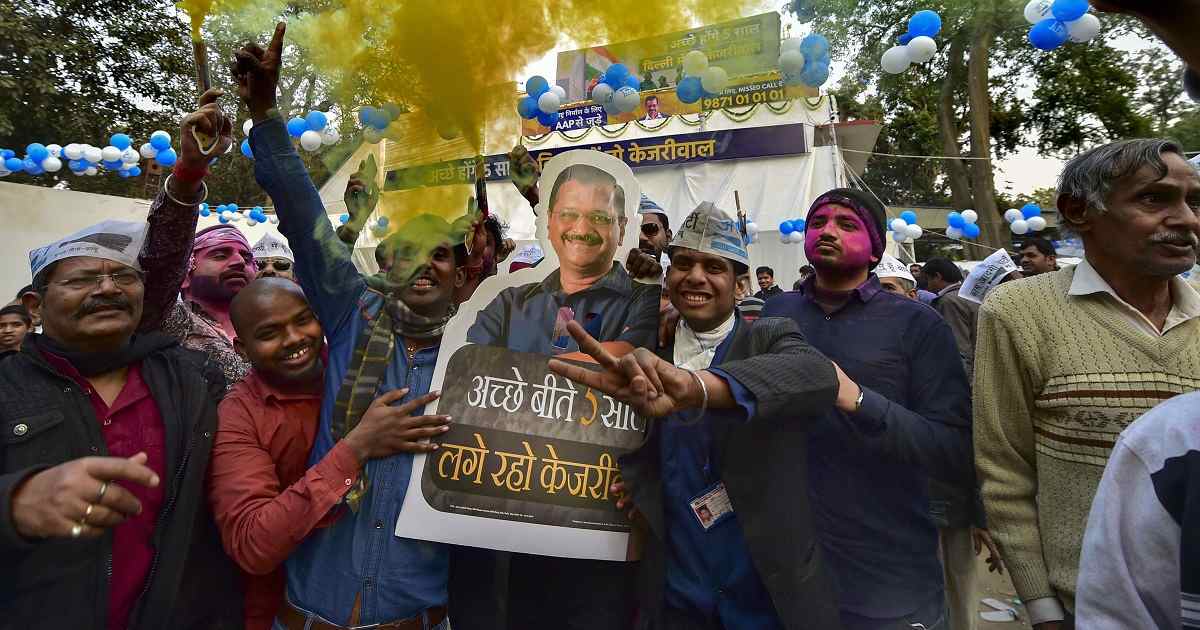The Aam Aadmi Party (AAP) entered the Delhi poll campaign on the strength of the development work it did in Delhi in its last term, staying away from the issues of the contentious Citizenship Amendment Act and National Register of Citizens. On the other hand, the Bharatiya Janata Party (BJP) weaved a poll pitch around nationalism and Hindutva, with its leaders making strong statements criticising the chaos resulting in Delhi owing to anti-CAA protests witnessed in
Chief Minister Arvind Kejriwal and his party’s restraint on issues relating to the citizenship law did not seem to upset voters in other Muslim-dominated seats, where the citizenship law is being protested. In Seelampur, Matia Mahal and Mustafabad too, the people gave the mandate to AAP, with winning candidates racing ahead of the runners-up with margins between 20,000 and 50,000. Moreover, voters came out in large numbers, with the turnout in Seelampur, Mustafabad, Babarpur, Matia Mahal and Seema Puri recorded at 71.4 percent, 70.55 percent, 65.4 percent, 68.36 percent and 68.08 percent respectively.
The Congress manifesto promised to pass a resolution in Delhi Assembly against CAA and ask the Central government to withdraw it. It had also promised that if it came to power, it would not implement NRC and NPR. But with the Sonia Gandhi-led party struggling to restore its footprint since the 2013 Delhi polls and the BJP government’s wavering stand over the CAA and NRC, Muslim votes have been wrested by the AAP.
Just as in the Congress’ case, a lack of prominent local faces cost the BJP too. The party’s Delhi chief Manoj Tiwari headed the campaign but was never declared the chief ministerial candidate. Top BJP leaders went on the campaign trail, with Shah addressing 52 public meetings, road shows and street meetings and Prime Minister Narendra Modi speaking at three public meetings.
Uttar Pradesh chief minister Yogi Adityanath addressed 12 public meetings in Delhi, including in the Shaheen Bagh area. However, the party’s leaders lacked the charisma and connect seen during the campaigns led by the late Sheila Dikshit of the Congress. Or now, the leader of the common man, Kejriwal.
Touted to be the feather in the BJP’s cap as far as Delhi was concerned, the Unauthorised Colonies Bill, which seeks to regularise 1,731 unauthorised colonies giving ownership rights to over 40 lakh residents, failed to strike a chord.
The AAP chief started his political party after emerging as one of the key faces of the India against Corruption campaign started with the demand to enact the Lokpal Bill. Earlier confrontational with the BJP-led Central government, on issues ranging from statehood to Delhi, demonetisation and the surgical strikes, Kejriwal moved his focus from political rivals to the people.
Amid a struggling economy and uproar over the CAA and NRC, Kejriwal picked the development agenda. The AAP started a campaign, highlighting its performance in improving the quality of government schools and mohalla clinics, providing subsidised water and electricity, installing CCTV cameras and ensuring free public transport for women. Apart from attending town halls, public meetings and road shows, the Delhi chief minister also featured on the ‘Aap Ke Dwar Kejriwal‘ interactive website.
The BJP’s campaign looked at national issues, but also trained the guns on AAP and the Congress, calling the anti-CAA stir their handiwork. While Union Minister Anurag Thakur got a campaigning ban over his “shoot the traitors” remark, another minister from Modi’s Cabinet Prakash Javadekar said, “You (Kejriwal) are a terrorist and there is plenty of proof,” he said, without giving any.
During one of his rallies, Modi said at a Dwarka rally that protesters at Jamia and Shaheen Bagh were holding the “Constitution and national flag, but hiding their intentions”. Meanwhile, Adityanath stated during his campaign that while the government fed “bullets to traitors”, Kejriwal AAP treated them with “biryani”.
The nationalist pitch, coupled with anti-incumbency, propelled BJP to a landslide win in the 2014 Lok Sabha polls. The same issues resonated with the voters who gave the saffron party a comfortable win in 2019.
At the state level, political imbroglios have ended with the BJP being in the governments in Haryana and Karnataka. Even Modi’s rigorous campaign failed to lift the party’s fortunes in Jharkhand, while BJD chief Naveen Patnaik became the Odisha chief minister for the record fifth term. The party could not retain power in Maharashtra either.
The contrast between the results of 2020 Delhi Assembly polls and the 2019 Lok Sabha elections, where the BJP won in all the seven Parliamentary constituencies in the National Capital, may also be a pointer to the fact that Delhi’s voters exercise their franchise differently on the national and state platforms.


